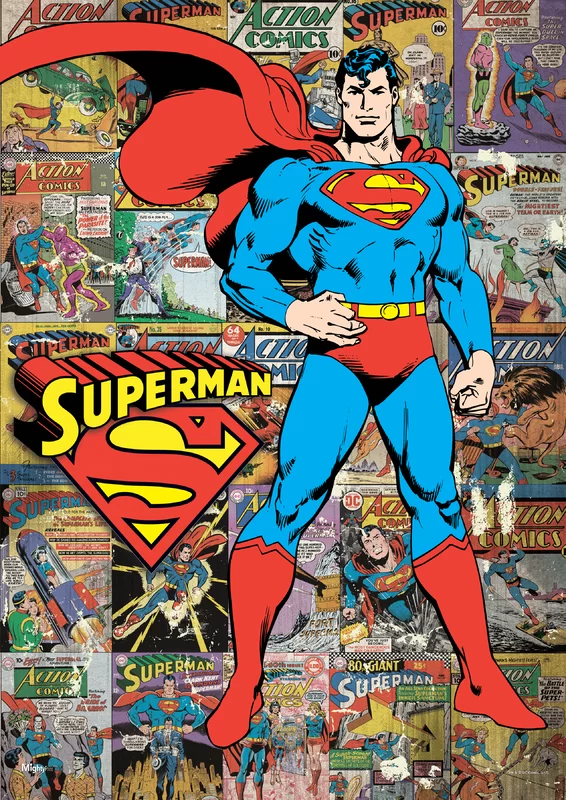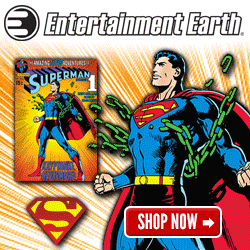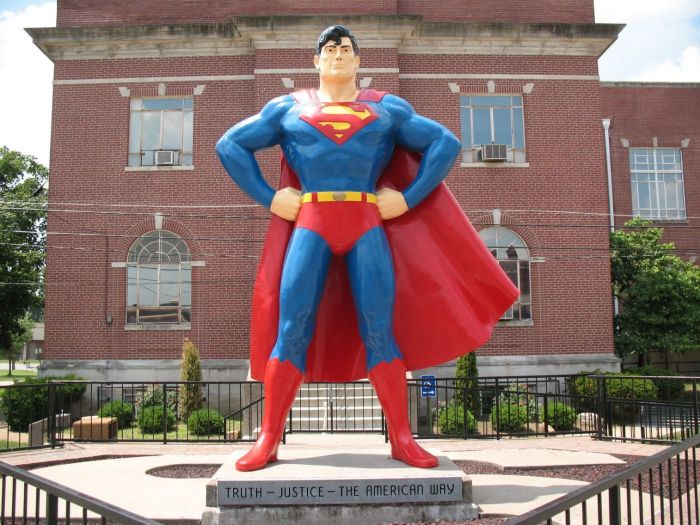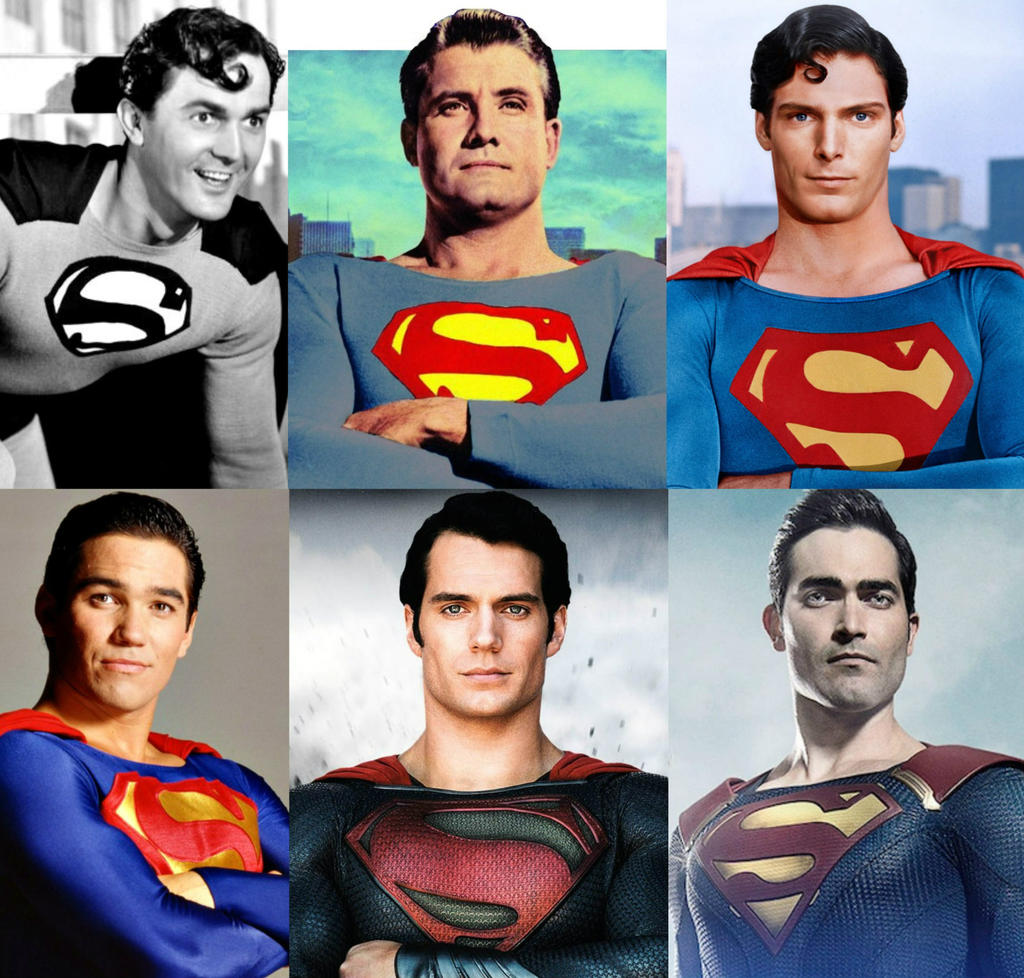
|
|
Superman Radio Program
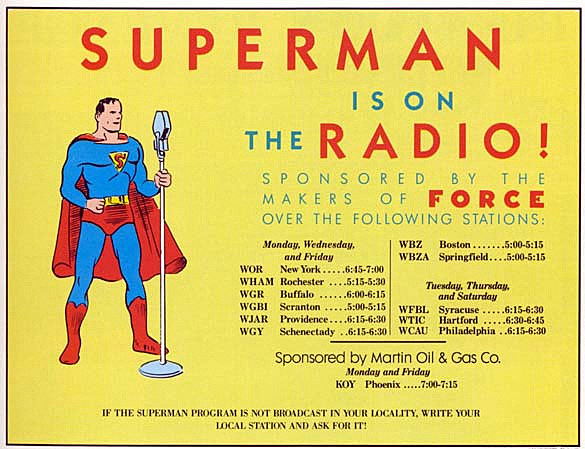
"Faster than an airplane, more powerful than a locomotive, impervious to bullets!"
"Up in the sky - look!"
"It's a giant bird!"
"It's a plane!"
"It's SUPERMAN!"
"And now, Superman - a being no larger than an ordinary man but possessed of powers and abilities never before realized on Earth: able to leap into the air an eighth of a mile at a single bound, hurtle a 20-story building with ease, race a high-powered bullet to its target, lift tremendous weights and rend solid steel in his bare hands as though it were paper. Superman - a strange visitor from a distant planet: champion of the oppressed, physical marvel extraordinary who has sworn to devote his existence on Earth to helping those in need!"
The signature was heard in endless variations over the airwaves and has become as much a part of the public's perception of Superman as his blue and red costume. However, the world-famous opening originated not in the four-color pages of the comic books, but on the long-running adventure serial that was one of the hallmarks of the Golden Age of Radio.
Although the Man of Tomorrow first appeared in Action Comics #1 in 1938, much of the mythology associated with Superman and many of the members of his supporting cast originated in his radio adventures. The characters of Daily Planet editor Perry White, copyboy Jimmy Olsen and police inspector Bill Henderson were created for the radio series. The Man of Steel encountered kryptonite in his radio adventures years before it appeared in the Superman comic books, and regularly teamed up with Batman and Robin on the airwaves before the trio joined forces in the pages of Superman and World's Finest. The influence of the radio series extended to the big screen as well. Paramount's 1940s Academy Award-nominated Superman theatrical cartoons featured voices from the radio cast, while the screenplays of Columbia's 1948 and 1950 Superman movie serials were adapted from the Superman radio program rather than from the original comic-book stories.
Superman flew onto the radio airwaves beginning Monday, 12 February 1940. The new series was developed by DC's press agent Allen Ducovny and Robert Joffe Maxwell, a former pulp fiction author who had been assigned the job of licensing the subsidiary merchandising rights to DC's popular comic book character for toys and commercial products. The duo was quick to realize that the vast radio audience could be used to extend Superman's popularity.
In 1939, Maxwell and Ducovny prepared several sample audition disks to sell the idea to prospective sponsors and co-wrote the first version of Superman's famous opening signature.
"We had a lot of fun writing that opening," Ducovny recalls, "It was a typical radio action piece that fully utilized sound effects."
Ten weeks after its debut, Superman achieved a Crossley rating of 5.6, the highest of any thrice-weekly program on the air. The early episodes of Superman were produced by Frank Chase, scripted by George Ludlum, and featured a repertory of the finest actors in New York radio. Ned Wever and Agnes Moorehead portrayed Superman's parents Jor-L and Lara in the premiere broadcast, with Jay Josten as Ro-Zan. Other early episodes featured the versatile Santos Ortega and future movie star Frank Lovejoy. The success or failure of the series would rest largely upon the actor chosen to portray the dual leads.
It came to pass that it was up to Bud Collyer to create the audio shorthand that would define the character to the listening audience. Collyer explains, "I played Clark Kent just a little bit higher to give my self somewhere to go with the 'UP, UP AND AWAY!'" Collyer portrayed Clark Kent as a tenor; dropping an octave in mid-sentence into Superman's deep baritone as he proclaimed: "This looks like a job - FOR SUPERMAN." Bud Collyer's portrayal of the Man of Steel remained the definitive interpretation throughout the 1940s.
Beginning in 1941, Collyer also provided the voice of Superman in the popular series of theatrical cartoons produced and directed by Max and Dave Fleischer and released by Paramount Pictures. The first of the Paramount Superman cartoons achieved new heights of realistic animation and was nominated for an Academy Award. Collyer's masterful portrayal of Clark and Superman served as an inspiration for Kirk Alyn's performance of the roles in the 1948 and 1950 Columbia movie serials. Collyer received no billing in the role and kept his superheroic alter ego a secret from the listening public, much as Superman conceals his dual identity as Clark Kent. Superman, Inc., the licensing arm of DC Comics, wanted the true identity of radio's Man of Steel to remain a secret to encourage the belief that the real Superman was starring in the broadcasts.
In addition to providing the voices of Superman and Clark Kent for the Superman radio show and the Fleischer cartoons, Bud Colyer also performed the roles during the 1960s on record albums and on television's animated The New Adventures of Superman (1966-1967), Superman-Aquaman Hour of Adventure (1967-1968), and Batman-Superman Hour of Adventure (1968-1969). "Of course, it grew into a magnificent career-within-a-career. It was great fun and a great way to get out all your inhibitions real fast. I love Superman, the guy who can fly through the air. It's the ultimate. So many people get the least bit embarrassed by fantasy when they're directing it or performing it and it loses all the great charm it should have, but if played honestly and whole-hog all the way, it's great."
Superman was absent from the premiere broadcast, although Bud Collyer was heard in background roles in the classic story of the doomed planet Krypton's destruction. In the radio version of Superman's origin, Krypton was a giant planet orbiting on the opposite side of Earth's sun, and the baby Kal-L would grow to manhood during his journey to Earth, emerging from his rocket ship as a full-grown adult in the second broadcast. On the advice of the first earthlings he meets, the strange visitor from another planet assumes the guise of Clark Kent and applies for a job as a great metropolitan newspaper to better study the human race.
Before the second episode came to an end, the mild-mannered Clark Kent was hired as a cub reporter by editor Perry White (introduced as "Paris White" on the earliest prototype audition shows). Since the Daily Planet editor was a new character created for the radio program by Bob Maxwell and Allen Ducovny, actor Julian Noa was allowed to develop his portrayal independent of the comic book and newspaper features. Julian Noa's blustery style set the standard for the character's later appearances in comic books and would eventually be echoed by actors Pierre Watkin and Jackie Cooper on film and John Hamilton, Jackson Beck, and Lane Smith on television.
In the seventh episode of the radio series, Superman investigates the theft of an atomic ray gun and meets the Daily Planet's veteran reporter, the eternally inquisitive Lois Lane, the only young, adult woman to co-star in this type of afternoon radio thriller. Lois Lane was initially portrayed by Rollie Bester, a respected radio character actress and the wife of science fiction, radio, and Green Lantern comic book writer Alfred Bester.
Rollie Bester and Helen Choate portrayed Lois Lane in the earliest days of the radio serial before Joan Alexander made the role her own for the remainder of the run. Bud Collyer particularly enjoyed working with her: "Joan is one of those rare actresses - especially in radio where you can't be seen and have to depend entirely on voice - who can go in on something cold and her instincts are so right as an actress that without even a rehearsal or a read-through, she is right. She is a joy to work with."
"On radio, you have to create a whole image and it isn't just with your voice - it's with your thoughts and your mind," Joan Alexander recalls. "You can't superficially play the result of a part; you have to play the action of a part."
In the 28th program, Kent was recruited by the Daily Planet's copyboy to investigate the protection racket that was victimizing his mother's candy store. The 15 April 1940 program featured the first appearance in any medium of copyboy (eventually cub reporter) Jimmy Olsen, eventually portrayed by Jackie Kelk for seven years and later by Jack Grimes. The character of Superman's pal Jimmy Olsen soon moved onto the comic book pages in 1942 and later starred in 163 issues of his own DC comic book, beginning in 1954. "Jimmy was a typical radio teenager," recalls co-creator Allen Ducovny, "cut from the same cloth as Henry Aldrich, Andy Hardy, and Archie Andrews."
Like his comic book predecessor, the radio Superman traveled around the world and even into outer space in a never-ending battle against evil and injustice. During the early seasons, Clark Kent and company journeyed to the Arctic in search of a lost explorer-turned-witch-doctor and traveled the American frontier with Tumbleweed Jones. The Man of Steel encountered 20-th century piracy on the high seas and discovered modern-day Incas in South America.
While investigating the mystery of a seemingly supernatural "Ghost Car" on 18 February 1942, Superman encountered a South American gaucho called Alfredo, played by the versatile Jackson Beck in his first appearance on the series. The following year, Beck took over as narrator after writer/narrator George Lowther succeeded Jack Johnstone as director. One of the greatest action/adventure narrators from the golden age of radio, Jackson Beck's forceful vocal delivery sounded more powerful that a locomotive and perfectly set the stage for The Adventures of Superman.
Radio listeners learned of kryptonite long before it appeared in Superman's comic books. "Superman for the first time in his life faces an enemy against which he is entirely powerless," proclaimed the series' narrator. "That enemy is a piece of the planet Krypton - kryptonite, it is called - which a few days ago struck the Earth in the form of a meteor. A full understanding of his danger came to Superman when he approached the kryptonite for the first time. As he came within five feet of the mass of metal, which glowed like a green diamond, he suddenly felt week, as if all his strength had been drained from him."
On 5 September 1945, the Man of Steel came to the rescue of an unconscious boy adrift in a rowboat. Superman was quick to notice that the young boy was wearing a red vest with the letter "R" under his street clothes. "Great Scott," he proclaimed. "If this boy is who I think it is, this is serious business!" Superman had rescued Robin, the Boy Wonder and sidekick of Batman. Five days later, the Man of Steel would rescue Batman, who would repay the favor by pinch-hitting for Superman during the years to come.
While the Man of Steel and the Caped Crusador had previously appeared together on symbolic comic book covers and in a brief cameo in a 1941 issue of All Star Comics, the 10 September 1945 radio broadcast was the first time that Superman and Batman worked together as a team. Batman and Robin would guest-star with Superman in 13 radio serials over the next several years, including one of the greatest adventure serials in the history of the series, "The Atom Man."
The Adventures of Superman radio series catapulted into the media spotlight with its "Unity House" story line in 1946. "Recently the Superman program underwent a change as drastic and unprecedented as some of its hero's exploits," wrote columnist Harriet Van Horne, "It became a program with a message." After years of battling mad scientists, atomic weapons and supernatural menaces, Superman took up the battle against racial and religious intolerance when a rabbi and a Catholic priest were menaced by young vigilantes out to destroy an interfaith community house. In the final installment, Superman tells the gang members, "Remember this as long as you live: Whenever you meet up with anyone who is trying to cause trouble between people - anyone who tries to tell you that a man can't be a good citizen because of his religious beliefs - you can be sure that troublemaker is a rotten citzen himself and an inhuman being. Don't ever forget that!"
"Superman is the first children's program to develop a social consciousness," reported Newsweek "To do it, Superman, Inc., the company that controls the Man of Tomorrow in all media, had to sell the idea to the Kellogg. Co. sposoners, and Mutual - two perpetual worriers over the response of reactionary listeners." Officials for both sponsor and network were relieved when the show's plea for tolerance began attracting the highest ratings in the history of the series. "Superman's Hooper rating has risen perceptibly since the change in plot." reported the New York World Tribune on 4 June 1946. "The show is now Number One." The story line attracted endorsements from dozens of organizations including the National Conference on Christians and Jews, the American Newspaper Guild, the American Veteran's Committee, the United Parents Association, the Associated Negro Press and the Boys Clubs of America. After years of protecting his dual identity, Bud Collyer finally stepped into the media spotlight to proudly promote the "Unity House" story line.
Superman also caused a considerable amount of bad feeling among the Ku Klux Klan by mentioning various KKK code words on the program. The code words had been passed on to Superman via the Anti-Defamation League. As a result, Samuel Green, Grand Dragon of the KKK, had to spend part of his afternoon with his ear pressed against the radio. As soon as Superman used a real KKK password, Green sent out urgent orders for a new one. The Grand Dragon is said to have taken this very badly and to have vented his spite on Kellog's Pep by attempting to stop local sales of the cereal. The Kellogg people refused to be intimidated.
The success of the "Unity House" series led to follow-up story lines on juvenile delinquency and school absenteeism. It was the finest moment in the history of radio's greatest adventure program.
Bud Collyer's decade-long tenure as radio's Superman was the longest run of any star of a radio adventure serial, lasting more than 2,000 shows. The 15 minute Mutual serial ran five days a week through 28 January 1949, then continued until 17 June 1949 as a thrice-weekly half-hour program. Collyer played Superman and Clark Kent in 325 syndicated episodes, through 1,610 15-minute shows, and 73 half-hour episodes on Mutual and ABC. Michael Fitzmaurice took over as ABC's Superman on 5 June 1950 and played the role for 78 broadcasts of a revived final season.
Superman left the radio airwaves on 1 March 1951 but arrived on television screens the following year. Bob Maxwell, the co-creator of the radio program, produced the first season of the television series. Radio characters Perry White, Jimmy Olsen, and Inspector Henderson were prominently featured alongside Clark Kent and Lois Lane on the new series.
